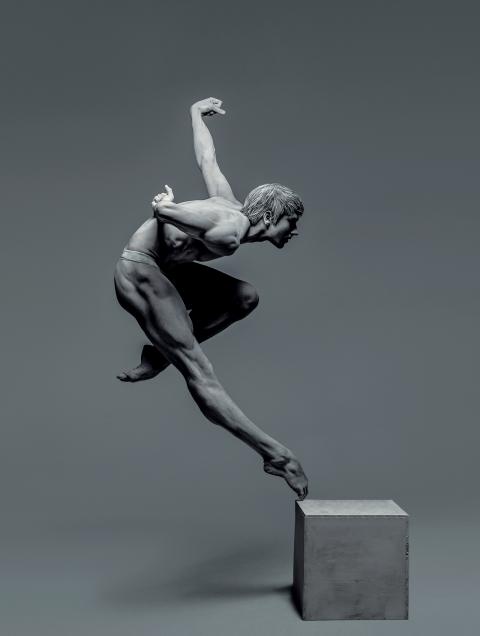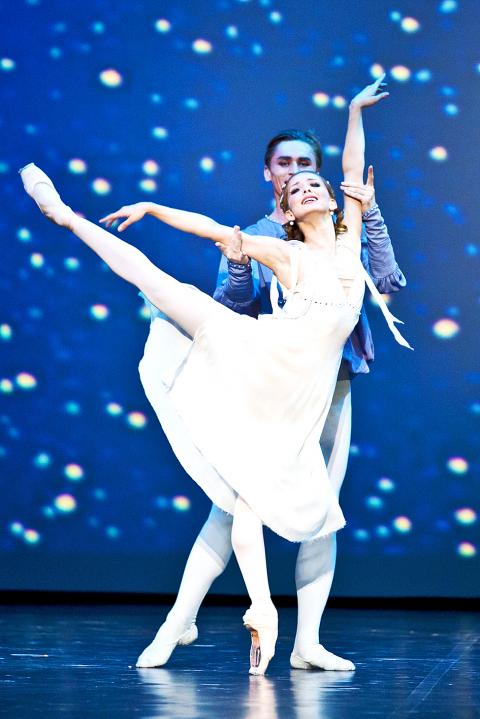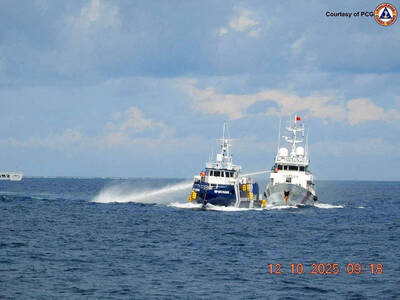Wang Tzer-shing (王澤馨) has really raised the barre for the 11th International Ballet Star Gala in Taipei (第十一屆 國際芭蕾舞星在台北) at the National Theater this weekend, while presenting ballet lovers with a major dilemma.
Not content with organizing a program replete with her usual mix of contemporary solos and duets by choreographers whose works Taipei audiences rarely have the chance to see live — such as Briton David Dawson or Taipei-born, California-raised Edwaard Liang (梁殷實), a former dancer with New York City Ballet and Nederlands Dans Theater — and classical ballet’s virtuoso pieces, she has come up with two completely different programs for Saturday night and the Sunday matinee.
It is complete madness, as she will be the first to tell you.

Photo Courtesy of BAKI
“I have never heard of anywhere else doing two programs over two days,” Wang said in a telephone interview on Monday night.
LONG TIME COMING
While admitting that she wanted some extra pizazz to attract audiences for what is the second gala she and her husband Chat Tzongue (謝宗益) have produced in Taiwan this year (their 10th International Ballet Star Gala was at the National Taichung Theater on Feb. 11), Wang said she had actually been thinking about the idea for a couple of years.

Photo Courtesy of Art Wave Inc
“This is the 11th gala. We have a lot of people who have seen every one... Years before I thought about doing two completely different shows because we have so many audience members who fly in from abroad for the weekend and see both shows,” she said.
“I started thinking about doing two programs a few months ago, so first I asked Friedemann Vogel, then Svetlana [Lunkina] and they said yes, so I asked the rest. Friedemann said it would be exciting for the dancers and audiences,” she said. “I really appreciate the dancers; they really trust and support us.”
As for the dancers themselves, there are several familiar favorites, such as Vogel, who is a principal dancer with the Stuttgart Ballet and is back for a fifth time, as well as new faces like his Stuttgart colleague Elisa Bandenes.
From the Staatsballett Berlin come husband and wife Mikhail Kaniskin and Elisa Carrillo Cabrera, who appeared with the company’s during its Taipei visit in 2013, while she also danced in the 2009 gala.
The National Ballet of Canada is represented by Svetlana Lunkina and Evan McKie. They were supposed to dance in the 2015 gala and perform the world premiere of Mask, which had been specially choreographed for the gala by British choreographer Douglas Lee, but McKie injured his back and could not come.
Lunkina did come, but the premiere of Mask had to be postponed. It is now on Sunday’s program.
Maria Kochetkova and Carlo Di Lanno are principals with the San Francisco Ballet, and this will be Kochetkova’s third appearance in Taipei. Taras Domitro used to be a principal with the company, but is now a freelancer and he will be making his first appearance in Taipei, as is Di Lanno.
American Ballet Theater’s Daniil Simkin is making his sixth trip to Taiwan and his second this year, while Igor Kolb of the Mariinsky Theatre is making his ninth trip: seven for Wang’s shows and twice with his company, in 2004 and 2006.
“Igor loves it here… When I asked him after the Taichung show if he could come back in August, he said: ‘Why do you bother asking?’” Wang said. “I told him he should apply for a multiple-entry visa, it would make his life easier.”
Round out the cast list are Bolshoi Theatre principal Evgenia Obraztsova and former Boston Ballet principal-turned-freelance guest artist Adiarys Almeida, who are making their first visits.
As for the two programs, both have several Taiwan or Asian premieres and only a few of the other pieces will be familiar to local audiences.
THIS WEEKEND’S PROGRAM
The program for Saturday night is: the Sleeping Beauty Pas de Deux (Kochetkova and Di Lanno); Scheherazade Pas de Deux (Carrillo and Kolb); the White Swan Pas de Deux from Dawson’s Swan Lake (Lunkina and McKie); John Cranko’s Legende (Bandenes and Vogel); Les Bourgeois (Simkin); a pas de deux from Leonid Lavrovsky’s version of Romeo and Juliet (Obraztsova and Kolb); Caravaggio Pas de Deux (Carrillo and Kaniskin); Pacopepepluto (Simkin); an excerpt from Christopher Wheeldon’s Within the Golden Hour (Kochetkova and Di Lanno); Limelight (Badenes) and the Don Quixote Pas de Deux (Almeida and Domitro).
Program B on Sunday is: La Peri Pas de Deux (Carrillo and Kaniskin); the Mirror Pas de Deux from Cranko’s Onegin (Obraztsova and Vogel); Capriccio (Mckie); a pas de deux from Liang’s Wunderland (Almeida and Domitro); The Dying Swan (Lunkina); Giselle Pas de Deux (Kochetkova and Di Lanno); the Balcony Pas de Deux from Cranko’s Romeo and Juliet (Badenes and Vogel); Mask (Lunkina and McKie); and excerpt from Multiplicity. Forms of Silence and Emptiness (Carrillo and Kaniskin); Parting (Obraztsova and Kolb); and Le Corasire (Almeida, Domitro and Simkin).
Asked which pieces she was most looking forward to, Wang mentioned Limelight, Multiple Cities, the Caravaggio excerpt and the Mirror Pas de Deux.
“The Multiple Cities pas de deux is short, but really amazing,” while Mirror will be the first time that Obraztsova and Vogel have performed together,” she said.
Laughing, she said: “Every year we try to put together a program that is different. This time there is not a single repeat. I’m proud of myself.”
DANCERS GO ‘ABOVE AND BEYOND’
However, Wang repeatedly emphasized that it is the dancers willingness to go above and beyond the norm that this weekend’s unusual double program is even possible. Their schedules are so tight that several are arriving tonight and tomorrow and five have to leave right after Sunday’s matinee, yet they are willing to put in the extra rehearsal hours to do two separate programs.
Wang, Chat and the dancers will be doing lighting and technical rehearsals all day tomorrow, with a full dress rehearsal for Program A on Saturday before the actual show and then the same again for Program B on Sunday.
“I really appreciate that they all think the galas here are just as important [as bigger places]. Even though it is not New York or London, they don’t have a ‘take the money and leave’ attitude,” Wang said.
Of course, a dancer does not rise to the rank of principal without putting in long, long hours of classes, rehearsals and performances, but some really do go above and beyond, such as Kochetkova, who earned a reputation on her previous visits for being the first to arrive at the theater and almost the last to leave.
“I had to leave Maria a note on the schedule that said ‘please do not arrive at the theater before 9am because the dressing rooms are not open before then,’” Wang said.

Many people noticed the flood of pro-China propaganda across a number of venues in recent weeks that looks like a coordinated assault on US Taiwan policy. It does look like an effort intended to influence the US before the meeting between US President Donald Trump and Chinese dictator Xi Jinping (習近平) over the weekend. Jennifer Kavanagh’s piece in the New York Times in September appears to be the opening strike of the current campaign. She followed up last week in the Lowy Interpreter, blaming the US for causing the PRC to escalate in the Philippines and Taiwan, saying that as

This year’s Miss Universe in Thailand has been marred by ugly drama, with allegations of an insult to a beauty queen’s intellect, a walkout by pageant contestants and a tearful tantrum by the host. More than 120 women from across the world have gathered in Thailand, vying to be crowned Miss Universe in a contest considered one of the “big four” of global beauty pageants. But the runup has been dominated by the off-stage antics of the coiffed contestants and their Thai hosts, escalating into a feminist firestorm drawing the attention of Mexico’s president. On Tuesday, Mexican delegate Fatima Bosch staged a

Taiwan can often feel woefully behind on global trends, from fashion to food, and influences can sometimes feel like the last on the metaphorical bandwagon. In the West, suddenly every burger is being smashed and honey has become “hot” and we’re all drinking orange wine. But it took a good while for a smash burger in Taipei to come across my radar. For the uninitiated, a smash burger is, well, a normal burger patty but smashed flat. Originally, I didn’t understand. Surely the best part of a burger is the thick patty with all the juiciness of the beef, the

Would you eat lab-grown chocolate? I requested a sample from California Cultured, a Sacramento-based company. Its chocolate, not yet commercially available, is made with techniques that have previously been used to synthesize other bioactive products like certain plant-derived pharmaceuticals for commercial sale. A few days later, it arrives. The morsel, barely bigger than a coffee bean, is supposed to be the flavor equivalent of a 70 percent to 80 percent dark chocolate. I tear open its sealed packet and a chocolatey aroma escapes — so far, so good. I pop it in my mouth. Slightly waxy and distinctly bitter, it boasts those bright,